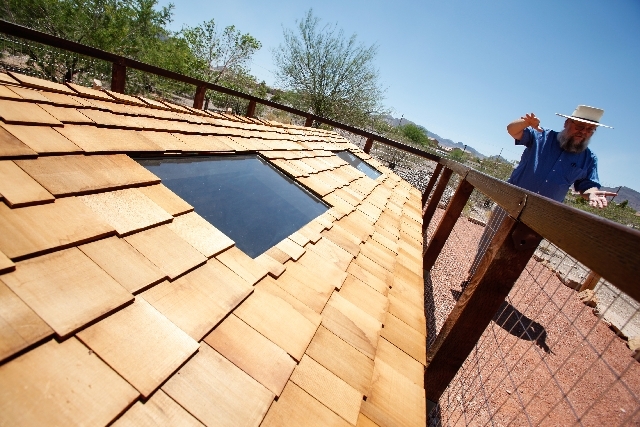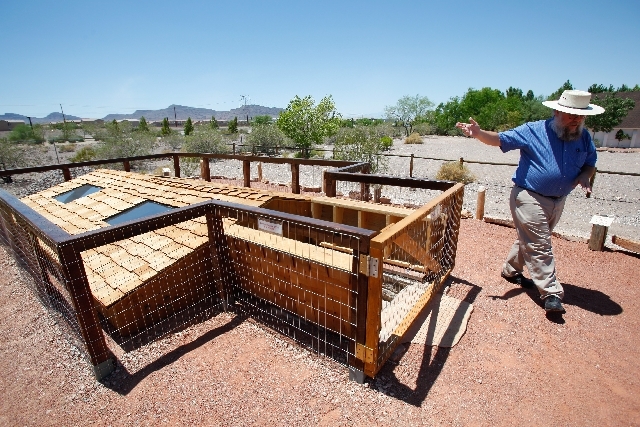Early settlers’ milk house now on display at Clark County Museum
A 1900s-era milk house recovered from during Las Vegas Wash area construction six years ago is among the Clark County Museum’s newest exhibits.
The 9-by-12-foot milk house, also known as a ranch cellar, was discovered by during construction near the Homestead and Lower Narrow weirs in 2007 and has since been dismantled and relocated to the museum at 1830 S. Boulder Highway.
According to Mark Hall-Patton, director of Clark County Museums, the milk house demonstrates what life was like in Las Vegas in the early 1900s.
“Finding the milk house in the Las Vegas Wash tells us more about what life was like in early Las Vegas,” Hall-Patton said. “We can learn about how a farm would have functioned in the Las Vegas Valley, an area where one doesn’t think of farming as being a big part of our history.”
The structure is estimated to have been built around 1907 by Allan Bishop, an early settler, as a way to preserve food such as milk, cheese or butter during the hot summer months.
Unlike the original cellar, which Hall-Patton said would have had a flat roof of dirt that acted as a thermo mask to keep the temperature 15 to 20 degrees cooler than the outside, the structure on display has a wood-shingled roof added to protect it from rain and debris and Plexiglas windows on the roof to allow museum visitors to see inside.
“This is not a restoration; it is a renovation and our re-creation of what was originally there,” Hall-Patton said. “This is yet another piece of the overall interpretation.”
Hall-Patton said construction of the Homestead and Lower weirs was put on hold for more than two years while archaeologists excavated the milk house site.
“The milk house couldn’t have been maintained in the Las Vegas Wash,” he said. “It was going to be destroyed by putting in the weir, so they excavated the whole thing and took everything out.”
Tim Ricks, environment biologist at the Southern Nevada Water Authority, said the Bureau of Reclamation’s main goal is to preserve as much archaeological history as possible.
“The site was located eight feet from a 40-foot drop to the Las Vegas Wash,” Ricks said. “It was located in the footprint of the construction (going on at the time) and in jeopardy of being destroyed.”
Among the artifacts that were collected were glass and porcelain jars, children’s toy jacks, broaches, a dime and a sack of flour. In addition, archaeologists discovered the stone foundation of what would have been a family residence where artifacts such as toys, jewelry and glass fragments from windows were found.
“Even trash ended up in there, but the trash, too, can teach us about history,” Hall-Patton said.
According to the Clark County Heritage Museum, homestead records show that Bishop settled the property in 1907 with his wife, four daughters and two sons. The original property included a blacksmith shop, barn, frame house, chicken coop and the milk house.
Ricks said the milk house was discovered by one of the construction managers on site who noticed a 2-foot row of stones sticking out of the dirt after vegetation clearing.
As the milk house was disassembled for the move to the museum, each stone was removed, documented and labeled. However, after sitting out in the elements for several years waiting for the historic preservation engineer to create reassembly plans that met permitting requirements, the markings on most stones wore off.
“The stones sat here for a few years on palettes just as piles of rocks,” Hall-Patton said. “They got rained on, and it was quite the jigsaw puzzle to put them together. After the layout was done, it took a couple of months to put the pieces back together.”
When the time came to reassemble the structure, most of the stones had to be repositioned using photographs. After a few years of sitting out in the dirt, every stone except one was put back into its original place.
The original structure was probably built about five feet into the soil and fortified using flat pieces of sandstone that may have been quarried from the nearby Rainbow Gardens area.
The milk house project was funded through a cooperative agreement with the Bureau of Reclamation. The Southern Nevada Water Authority also provided the contract for the renovation of the milk house.
The milk house is now open to the public, and a formal dedication is expected to be announced in the fall.
The Clark County Museum is open from 9 a.m. to 4:30 p.m. daily. Admission is $2 for adults and $1 for seniors and children. Group tours and museum memberships are available. For more information, call 702-455-7955.
Contact reporter Sandy Lopez at slopez@reviewjournal.com or 702-383-4686.






























